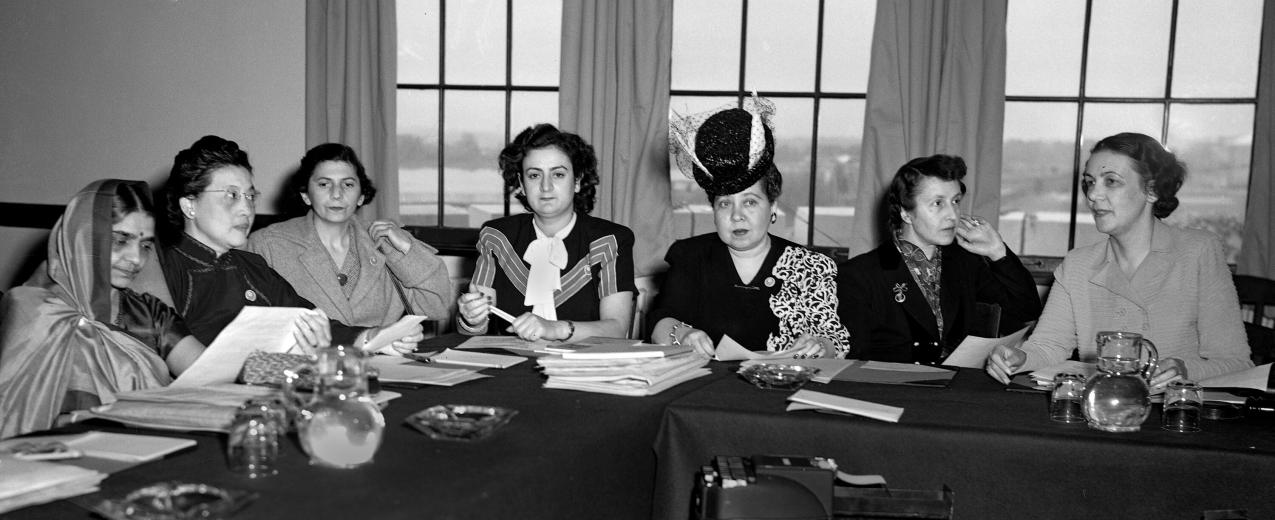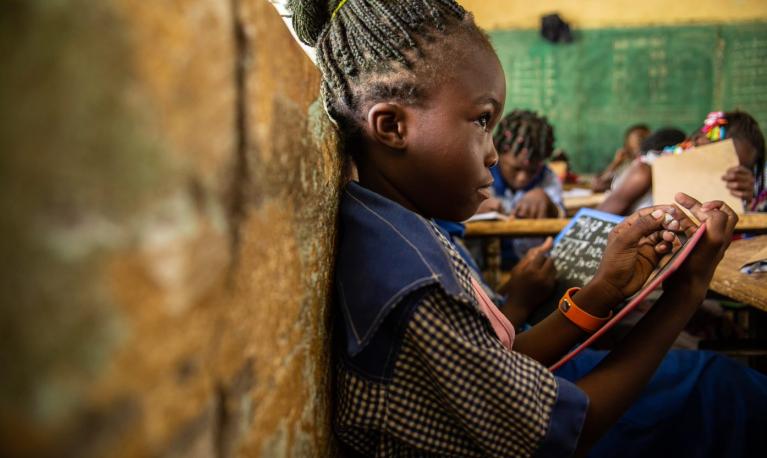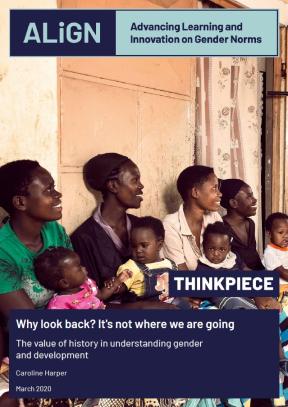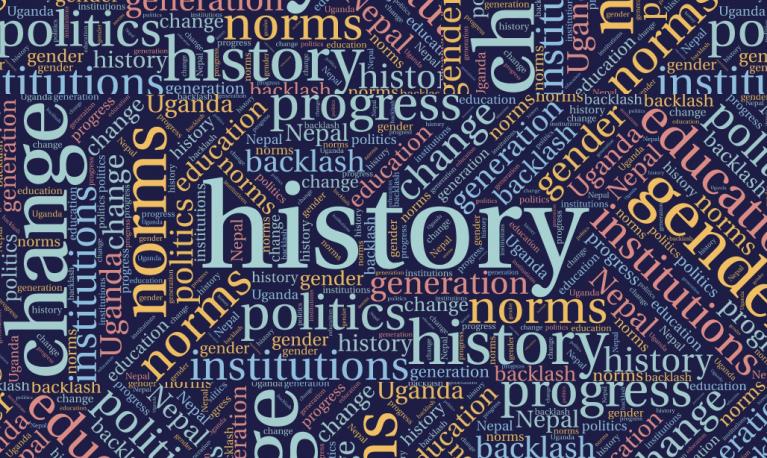
- Blog
- 1 Octubre 2020
25 years after Beijing: Time to kick-start a new era for gender equality through norm change
- Author: Sophia M. D’Angelo
- Published by: ALIGN

In the 25 years since the United Nations' Beijing Conference on Women, there has been major progress in the fight for gender equality. Emerging from this historic event was the Beijing Declaration and the Platform for Action, one of the most comprehensive global policy frameworks for women. Since then, it has been used as a springboard for greater gender equality by governments, civil societies, development agencies, and activists all over the world. Progress has been driven, in part, by a sharper focus on gender and social norms within policy spaces since Beijing in 1995.
An earlier ALIGN blog argued that we need to focus on gender norms to reach the global goals on education. The same holds true for many other areas as well. Gender norms shape inequalities around women’s health, economic empowerment and political participation. Therefore, if policy actors are to tackle these inequalities, they must commit to changing such norms. Governments have the power to pass laws that signal a ‘new normal’, challenging the norms that still hamper progress for women. Since Beijing, many governments have demonstrated a growing commitment to addressing these norm-based inequalities. But what have they done to tackle the harmful gender norms themselves? Annual country reports from the past 25 years reveals the evolution and expansion of policy discourse around gender and social norms.
The evolution of high-level policy discussion on norms since Beijing
Few country submissions mentioned norms at the time of Beijing. Instead, governments focused on overarching inequalities, such as lack of access to education, or gender-based violence (GBV) at the household level. They did not explore how education itself is shaped by gender norms. Nor did they recognise the diverse forms of GBV in public spheres such as the workplace, through economic and sexual exploitation, or emotional and psychological violence. And they did not identify gender norms as a root cause of such injustice.
There were a few exceptions at the 1995 conference. The Prime Minister of Pakistan shared her personal story of how ‘the norm’ had changed since she was a child: ‘When I was growing up, the boy cousin inevitably took a second wife. Now girls do not expect their husbands to marry again. From the norm, it has become the exception to the norm.’ The representative of Finland spoke of men ‘changing their traditional roles and attitudes’, while the representative of Norway noted that the representation of women in politics was becoming ‘normal’.
So yes, there were hints at how norms shape gender inequality at home, in schools, and in the workplace. What was missing, however, was an explicit effort to change those pervasive norms that put women at a disadvantage.

Fast-forward to 2010, and a stronger focus on gender roles starts to emerge in country submissions. Countries such as Bosnia and Herzegovina and Romania, for example, highlighted the role of the media in shaping traditional gender roles, how women are seen as mothers and caregivers, while men play the role of family breadwinners. Other countries, including Malta and Pakistan, started to address stereotyped representations in textbooks and other educational materials. Overall, there was a growing recognition that, as the Estonian report states, ‘people still tend to base their decisions on traditional gender roles and expectations’. The 2010 statements also pushed for women’s greater participation in formal labour markets, particularly in male-dominated sectors such as engineering and medicine.
Because of this, the first decade of the new millennium saw several key policies and strategies to shift gender norms, including childcare centres and paternal leave policies in Czech Republic and Latvia and campaigns encouraging women to pursue careers in STEM subjects in Germany and Thailand.
Norm change and women’s empowerment today
Now, a decade later, we have seen major progress on gender equality, built on these earlier foundations of discussion on gender norms in high-level policy spaces. There is a stronger focus on gender norms as a root cause of inequalities and as an area for urgent action. ALIGN is preparing a flagship report on how gender norms have changed worldwide and how they shape trends around women’s economic empowerment, education, sexual and reproductive health and rights and political participation. Our initial key findings are that:
- the share of the global population who believe ‘men make better leaders’ fell from 50% to 40% between the mid-1990s and late 2000s, with significant country differences
- the share of those agreeing that university is more important for boys than for girls has fallen slightly (26% to 21% of men, and 22% to 16% of women) from the mid-1990s to mid-2010s
- the share of women who experience either sexual or physical intimate partner violence has decreased in 18 out of 24 countries (75%) since 2000. It has remained unchanged in one country (Dominican Republic) and has increased in five countries. In countries where physical violence is more prevalent, women tend to be more accepting of wife beating.
Our findings suggest there has been progress in some areas but not others, signalling that changing norms is a long and complex process, despite an increased focus on gender norms in policy spaces. Our analysis of country reports produced for this year’s Beijing Anniversary CSW meeting found that out of 32 countries, 24 (or 75%) had some level of focus on gender norms and norm change, setting out a new vision that recognises the fight for women’s equality as a matter of entrenched cultural norms.
Many countries have broadened their policy agendas to capture the multifaceted nature of gender equity. Reports from several African countries, for example, focus on norms around women’s sexual and reproductive health as an area for action, linking discriminatory behaviour with cultural norms. The report from Malawi describes how HIV and AIDS prevention efforts are shaped by ‘the prevailing gender norms associated with the harmful cultural practices’ and Uganda recognised how ‘customary social norms and practices continue to aggravate the freedom of women and girls and exacerbate harmful traditional practices such as Female Genital Mutilation (FGM) and early forced and child marriage’.
Many countries in Asia expand upon these traditional practices to discuss norms in the context of power relations, including domestic violence, sex trafficking and cyber-violence. This contrasts starkly to the more narrowed focus on intimate partner violence seen in the country statements of 1995.

Talk vs. action: comprehensive approaches needed for norm change
Despite the growing focus on gender norms, policy discourse does not always translate into action, let alone action that shifts norms. This raises two questions.
- Are countries acting directly to shift gender norms?
- How far does policy actually translate into practice?
There are no simple answers, but research suggests that laws alone are not enough. Some countries may lack the capacity to enforce or monitor such laws, and within systems, gender norms may also shape how people act on the law, whether they choose to follow it or not. Gender norms have, for example, shaped how health providers respond to their clients, employers treat their employees, or police officers enforce legislation. In addition, new legislation is often met by resistance from conservative political parties or religious organisations.
To drive real norm change, these norms must be addressed at every level of the social system. Policies developed at the centre need to be combined with initiatives that work with individuals, community members and institutions. It is critical to build awareness and sensitivity around gender norms through, for example, mass messaging campaigns to shift people’s attitudes. People also need to be informed of their rights and be confident that there are reliable structures in place to help them if their rights are violated.

The good news is that more countries are recognising the need for comprehensive action to change norms. Many country reports for this year’s CSW, including those for Bangladesh, Cambodia, Kyrgyzstan and Malawi, outline practical strategies to address norm change through community mobilisation and campaigning. Afghanistan and Myanmar are using media campaigns to shift norms around GBV, while Nepal is using both awareness-raising campaigns and behaviour-change communication to combat harmful religious practices, such as dowry and child marriage.
This kind of action, combined with gender equitable legislation and policy commitment, fuels efforts to change norms. And we need to change norms if we are to kick start a new era for gender equality.
About the author

- Tags:
- History and change
- Countries / Regions:
- Global


